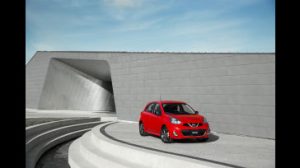Try saying it’s a cute cup coup three times fast without smiling. On the surface, the Nissan Micra Cup is a unique and homegrown success story, a 4-year old racing series in Quebec and Ontario, using only Nissan Micras.
Why is it called Micra? It’s one of the smallest cars sold in Canada. How is the Cup unique? “Anyone who’s had a lifelong dream to race can do so at a fraction of the costs of other series,” says Jacques Deshaies, series Promoter and originator of the Nissan Micra Cup idea.
With tight rules for spec’ing — you buy your own new race car (at which point it’s no longer street legal) completely finished for $23,400, plus taxes — the series field is level. So, “the only difference among the competing cars exists between the steering wheel and the seat.”
Starting at $9,988, the Micra is inarguably the cheapest car in the country.
 Of course, that doesn’t stop the arguing from Didier Marsaud, Nissan Canada’s Director of Corporate Communications. A native French speaker impeccably fluent in English, Marsaud is well aware of the secondary meaning of cheap. “The Micra is the most affordable in Canada,” he counters with all the passion of a race fan.
Of course, that doesn’t stop the arguing from Didier Marsaud, Nissan Canada’s Director of Corporate Communications. A native French speaker impeccably fluent in English, Marsaud is well aware of the secondary meaning of cheap. “The Micra is the most affordable in Canada,” he counters with all the passion of a race fan.
Okay, affordable. Fair enough. The Micra Cup is also the most affordable race series. With total fees of under $10,000 for a complete 12-race season, you could support your habit by AirBnB-ing out your stepmother’s treehouse for a few weeks and call it an Elevated Digital Detox Retreat.
But any student of business should take a magnifying glass to this airtight case study.
First, there’s that ugly side of being the “most affordable.” Meaning? People think you’re cheaply made. But consider: surely any car that can handle the abuse of a full-fledged race series must be endurable. Despite not being street legal, Micra race cars are completely made of stock parts but for three-component systems.
Before launching the series, to prove they’re endurable “we had a professional driver push a Micra for 45 hours on the track and it performed perfectly throughout” says Marsaud. “Actually, it was 50 hours” Deshaies corrects him.
45, 50, either way, that’s the quality issue covered. Next, there’s the issue of publicity costs. Remember that base price under 10k? It had a consequence.
“There wasn’t much of a marketing budget” Marsaud effortlessly recalls.
But consider the constant press any racing series gets without paying for it. All season it’s reported in both the specialty race publications and major papers’ sports sections.
The Nissan Micra Cup, however, also garners plenty of extra attention because of the novelty/charm factor. At the  Series Races 9 & 10 this past weekend at Canadian Tire Motorsport Park, one fan cheekily observed, “they look like Smarties out there.” A couple of people tweeted the thought.
Series Races 9 & 10 this past weekend at Canadian Tire Motorsport Park, one fan cheekily observed, “they look like Smarties out there.” A couple of people tweeted the thought.
Which brings us to social media. Pictures and videos of the drivers gleefully throwing these rolling toadstools with 109hp of muscle into the red make charmingly excellent Instagram and Youtube posts.
In short, overcoming low promotional budgets which they would use to talk about themselves, Nissan has other people doing much of the talking for them.
So, let’s summarize. This series allows would-be racers to realize their dreams … umm … affordably; continually demonstrates the inherent quality of the hard-driven cars, countering any cheap claims; is mentioned continually throughout race season on multiple traditional media, free; and gets both its purveyors and us posters bags of extra retweets.
Promoters of more traditional races are licking their chops in envy.


